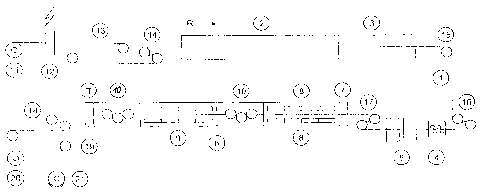Some of the information on this Web page has been provided by external sources. The Government of Canada is not responsible for the accuracy, reliability or currency of the information supplied by external sources. Users wishing to rely upon this information should consult directly with the source of the information. Content provided by external sources is not subject to official languages, privacy and accessibility requirements.
Any discrepancies in the text and image of the Claims and Abstract are due to differing posting times. Text of the Claims and Abstract are posted:
| (12) Patent Application: | (11) CA 2749962 |
|---|---|
| (54) English Title: | METHOD AND DEVICE FOR ANNEALING AND DESCALING STRIPS OF STAINLESS STEEL |
| (54) French Title: | PROCEDE ET DISPOSITIF POUR RECUIRE ET DECALAMINER UNE BANDE D'ACIER INOXYDABLE |
| Status: | Deemed Abandoned and Beyond the Period of Reinstatement - Pending Response to Notice of Disregarded Communication |
| (51) International Patent Classification (IPC): |
|
|---|---|
| (72) Inventors : |
|
| (73) Owners : |
|
| (71) Applicants : |
|
| (74) Agent: | SMART & BIGGAR LP |
| (74) Associate agent: | |
| (45) Issued: | |
| (86) PCT Filing Date: | 2009-12-22 |
| (87) Open to Public Inspection: | 2010-07-29 |
| Examination requested: | 2011-07-18 |
| Availability of licence: | N/A |
| Dedicated to the Public: | N/A |
| (25) Language of filing: | English |
| Patent Cooperation Treaty (PCT): | Yes |
|---|---|
| (86) PCT Filing Number: | PCT/DE2009/001832 |
| (87) International Publication Number: | DE2009001832 |
| (85) National Entry: | 2011-07-18 |
| (30) Application Priority Data: | |||||||||
|---|---|---|---|---|---|---|---|---|---|
|
The invention is directed to a method for annealing and descaling hot-rolled
austenitic
stainless steel strip. According to the invention, the steel strip is descaled
in a connected
plasma descaling installation after annealing and subsequent cooling. The
plasma descaling
is carried out under vacuum in a plurality of stages, and the steel strip is
subjected to a
controlled cooling between these stages and after the final stage by means of
cooling rolls so
that the steel strip has a temperature below 100 °C when exiting the
plasma descaling
installation.
La présente invention concerne un procédé pour recuire et décalaminer une bande d'acier inoxydable austénitique laminée à chaud. Selon l'invention, la bande d'acier, après avoir été recuite puis refroidie, est décalaminée dans une installation de décalaminage au plasma couplée, le décalaminage au plasma s'effectuant sous dépression en plusieurs étapes et la bande d'acier subissant, entre ces étapes et après la dernière étape un refroidissement régulé au moyen de cylindres de refroidissement de sorte que la bande d'acier se trouve à une température inférieure à 100 °C à sa sortie de l'installation de décalaminage au plasma.
Note: Claims are shown in the official language in which they were submitted.
Note: Descriptions are shown in the official language in which they were submitted.

2024-08-01:As part of the Next Generation Patents (NGP) transition, the Canadian Patents Database (CPD) now contains a more detailed Event History, which replicates the Event Log of our new back-office solution.
Please note that "Inactive:" events refers to events no longer in use in our new back-office solution.
For a clearer understanding of the status of the application/patent presented on this page, the site Disclaimer , as well as the definitions for Patent , Event History , Maintenance Fee and Payment History should be consulted.
| Description | Date |
|---|---|
| Application Not Reinstated by Deadline | 2013-12-24 |
| Time Limit for Reversal Expired | 2013-12-24 |
| Deemed Abandoned - Failure to Respond to Maintenance Fee Notice | 2012-12-24 |
| Inactive: Correspondence - PCT | 2011-10-13 |
| Inactive: Cover page published | 2011-09-16 |
| Letter Sent | 2011-09-06 |
| Inactive: IPC assigned | 2011-09-06 |
| Application Received - PCT | 2011-09-06 |
| Inactive: First IPC assigned | 2011-09-06 |
| Inactive: IPC assigned | 2011-09-06 |
| Inactive: Acknowledgment of national entry - RFE | 2011-09-06 |
| Request for Examination Requirements Determined Compliant | 2011-07-18 |
| All Requirements for Examination Determined Compliant | 2011-07-18 |
| National Entry Requirements Determined Compliant | 2011-07-18 |
| Application Published (Open to Public Inspection) | 2010-07-29 |
| Abandonment Date | Reason | Reinstatement Date |
|---|---|---|
| 2012-12-24 |
The last payment was received on 2011-11-21
Note : If the full payment has not been received on or before the date indicated, a further fee may be required which may be one of the following
Patent fees are adjusted on the 1st of January every year. The amounts above are the current amounts if received by December 31 of the current year.
Please refer to the CIPO
Patent Fees
web page to see all current fee amounts.
| Fee Type | Anniversary Year | Due Date | Paid Date |
|---|---|---|---|
| Basic national fee - standard | 2011-07-18 | ||
| Request for examination - standard | 2011-07-18 | ||
| MF (application, 2nd anniv.) - standard | 02 | 2011-12-22 | 2011-11-21 |
Note: Records showing the ownership history in alphabetical order.
| Current Owners on Record |
|---|
| SMS SIEMAG AKTIENGESELLSCHAFT |
| Past Owners on Record |
|---|
| HANS-GEORG HARTUNG |
| HOLGER BEHRENS |
| KLAUS FROMMANN |
| LUTZ KUEMMEL |
| MATTHIAS KRETSCHMER |